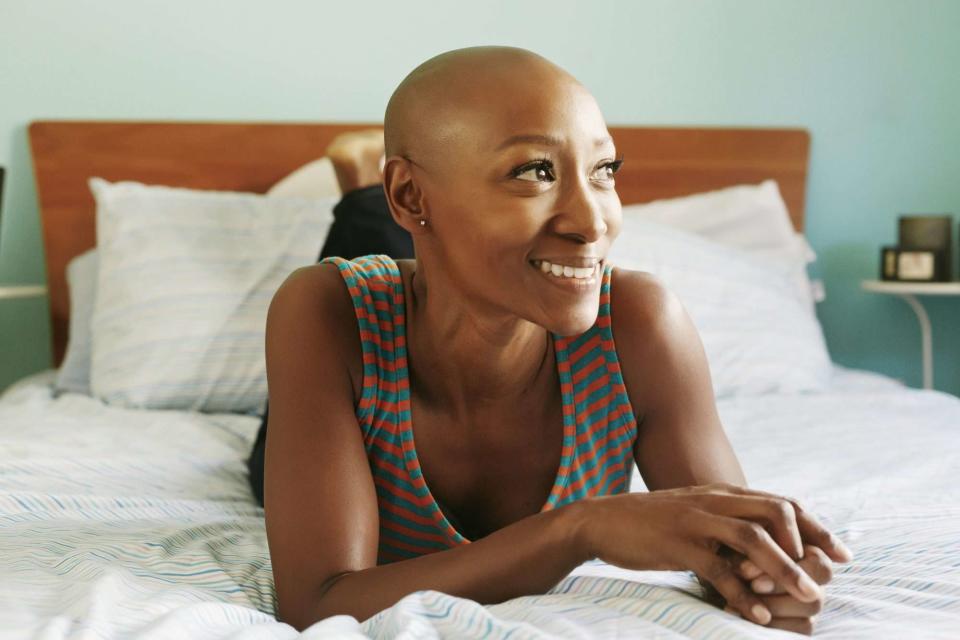What To Expect With Hair Growth After Chemo
Hair loss is one of the most common side effects of chemotherapy, but it is not permanent.

With hair regrowth after chemo, You may notice changes to the color and texture of your natural hair. Chemotherapy is a treatment that gets rid of cancer cells. Some of the medicines that chemo uses also attack your healthy cells, including those that make up your hair roots. As a result, chemo often leads to hair loss.
Typically, hair regrowth starts two to three months after stopping chemo. Most people fully recover their hair within six to 12 months. A healthcare provider may advise treatments like iron and zinc supplements if your hair does not regrow during that time.
Although no effective treatments speed up hair regrowth, you can take care of your hair and scalp to promote hair wellness. For example, do not wash it more than twice weekly, and use baby shampoo when you do so.
Read on to learn more about hair regrowth after chemo, including what to expect and how to care for your hair.
Standard Disclaimer
Dietary supplements are minimally regulated by the FDA and may or may not be suitable for you. The effects of supplements vary from person to person and depend on many variables, including type, dosage, frequency of use, and interactions with current medications. Please speak with your healthcare provider or pharmacist before starting any supplements.

Chemotherapy and Hair Loss
Typically, your body gets rid of abnormal cells before they grow out of control. With cancer, those abnormal cells divide and spread to other parts of the body. Chemotherapy is a treatment that uses medicine to get rid of cancer cells.
Chemo cannot only target cancer cells. The treatment can damage your healthy cells, too. In response, you may experience side effects, including hair loss, or alopecia.
The medicines in chemo that affect your hair growth are called cytostatic drugs. Cytostatic drugs suppress cell growth, which may damage the cells that make up your hair roots. As a result, your hair can break off and fall out.
Chemo does not always cause hair loss. Factors such as the chemo dose and how you take the treatment (i.e., as a tablet or infusion) influence the severity of hair loss.
Of note: Other cancer treatments may cause hair loss, too. For example, hair loss is a side effect of tamoxifen, which treats and prevents breast cancer.
Timeline for Hair Regrowth
Typically, hair loss begins one to three weeks after starting chemo. Scalp hair falls out, followed by facial, body, and pubic hair.
After stopping chemo, hair regrowth starts two to three months later. Typically, hair returns in three to six months. Most people have full hair recovery in six to 12 months.
A study published in 2019 found that among people who used wigs during and after chemo, 53% stopped using wigs after one year. On average, wig use lasted 12.5 months.
"If regrowth is not happening that quickly, talk to [a healthcare provider] about the likely causes," Mario Lacouture, MD, a dermatologist at the Memorial Sloan Kettering Cancer Center in New York, told Health. "These may include treatment-induced low levels of zinc or iron, thyroid problems, or stress."
According to Dr. Lacouture, to address those problems, talk to a healthcare provider about treatments like:
Anti-anxiety medicines
Antidepressants
Iron or zinc supplements
Thyroid hormones
Very rarely does hair not regrow after stopping chemo. Usually, hair regrowth only does not happen after very high doses of certain medications.
Related: What You Need To Know About 'Chemo Curls'
What Hair Growth After Chemo Looks Like
You may notice changes in your hair's color and texture as it regrows. Some of the most common changes that occur with hair regrowth after chemo include:
Color changes (i.e., darker or lighter)
Fine hair
Texture changes (i.e., straight hair becomes curly, or curly hair becomes straight)
Over time, your hair may return to its natural color and texture. Rarely do people have scarring on their scalp from hair loss.
What Helps Hair Regrowth After Chemo?
There are no effective treatments for speeding up hair regrowth after chemo. More research is needed to know whether treatments like Rogaine (minoxidil) are effective after stopping chemo.
Still, there are several steps you can take to keep your hair healthy while it regrows, such as:
Avoid using hot tools like hairdryers and irons, gels, and clips that may damage your hair.
Do not wash your hair more than twice weekly.
Gently pat your hair dry with a soft towel after washing it.
Use a hairbrush with soft bristles or a wide-toothed comb to detangle your hair.
Use baby shampoo.
As your hair regrows, you will also want to use sunscreen on your scalp or wear a hat outdoors. Lotions and conditioners can help alleviate itchiness.
After your hair fully recovers, consult an oncologist and dermatologist before coloring, bleaching, and perming your hair.
Hair loss can be challenging for many people undergoing chemo. You may feel angry, embarrassed, or sad about losing your hair. As your hair regrows, it may help to talk with people who have experienced hair loss.
Related: How To Donate Your Hair to People with Hair Loss
A Quick Review
Hair loss is a common side effect of chemotherapy but is not permanent. Typically, hair regrowth starts two to three months after stopping chemo, and many people fully recover within 12 months. Remember to be gentle with your hair as it regrows.
For more Health news, make sure to sign up for our newsletter!
Read the original article on Health.

